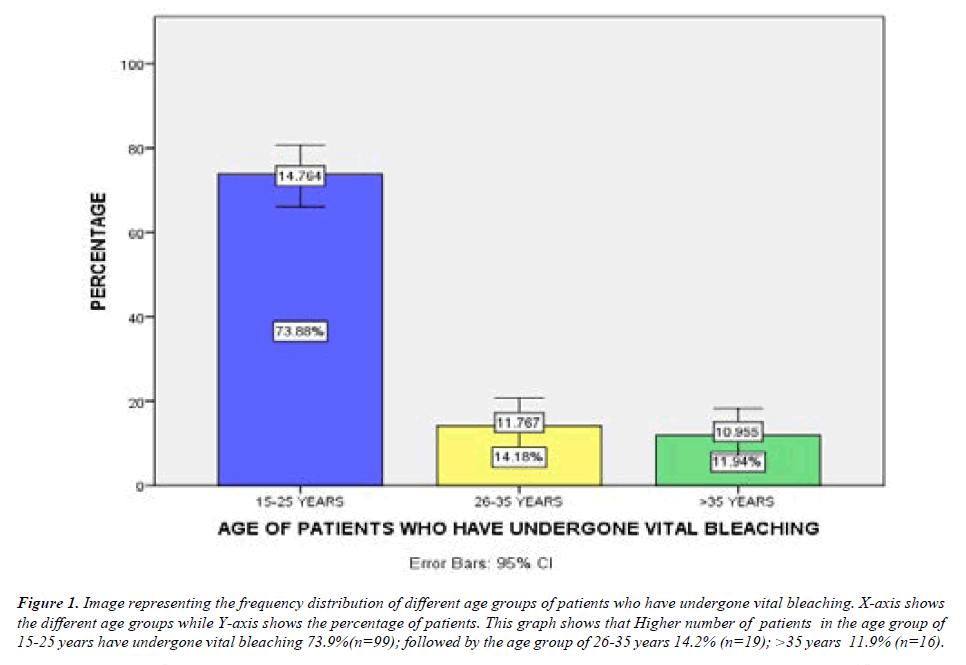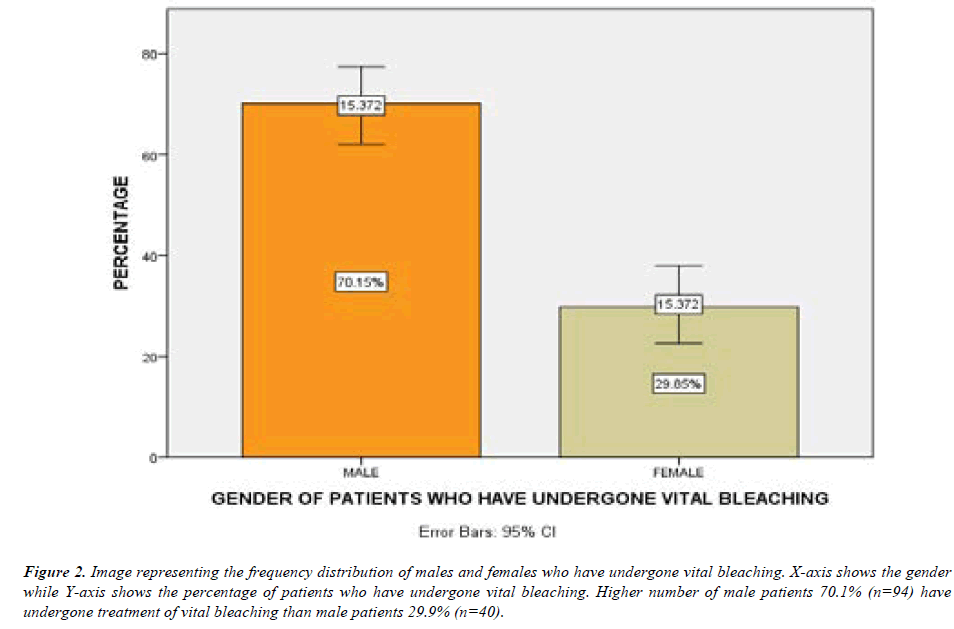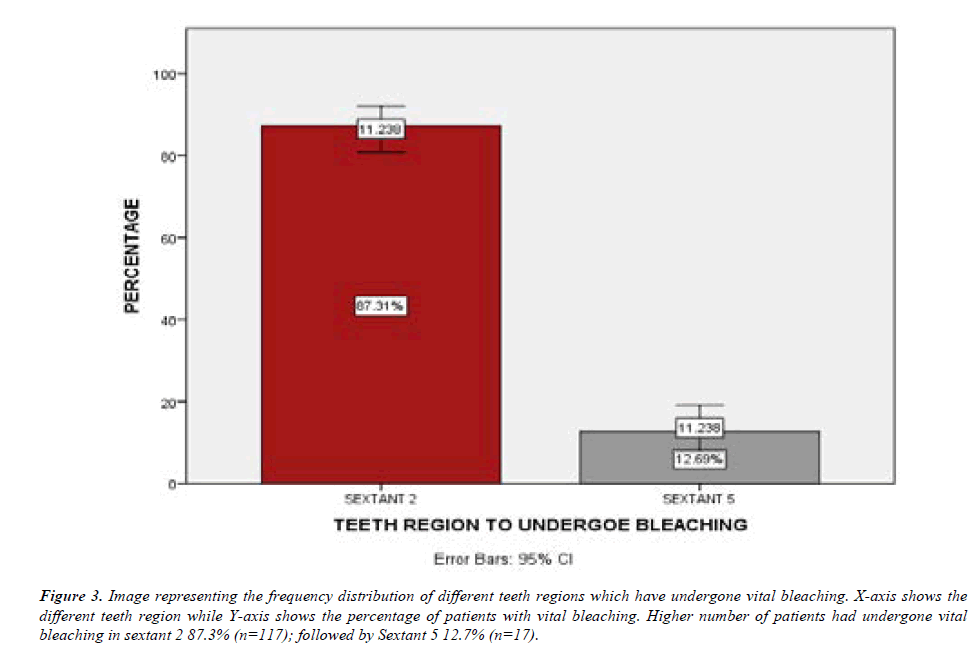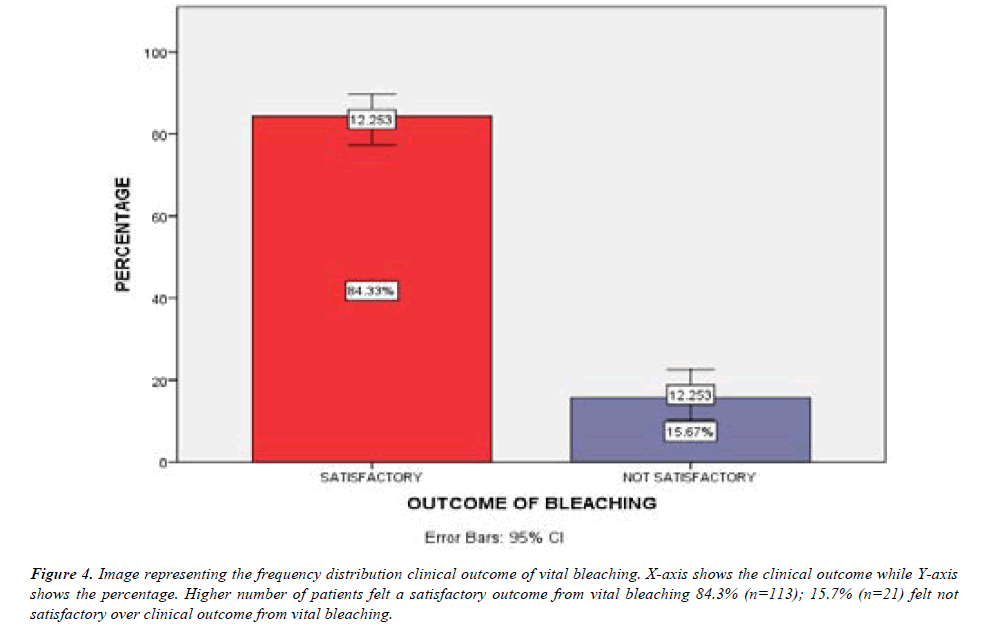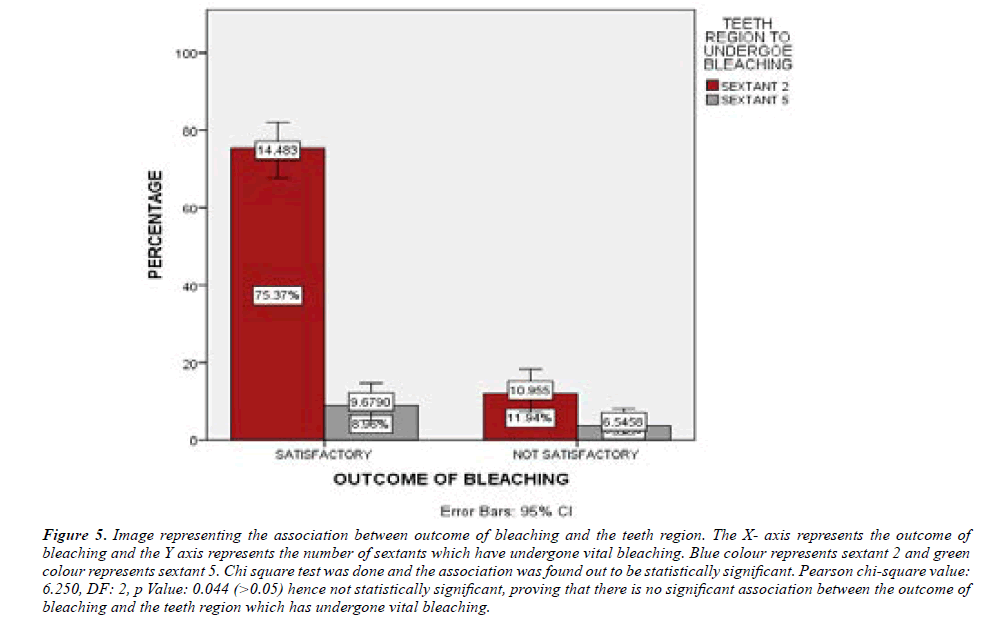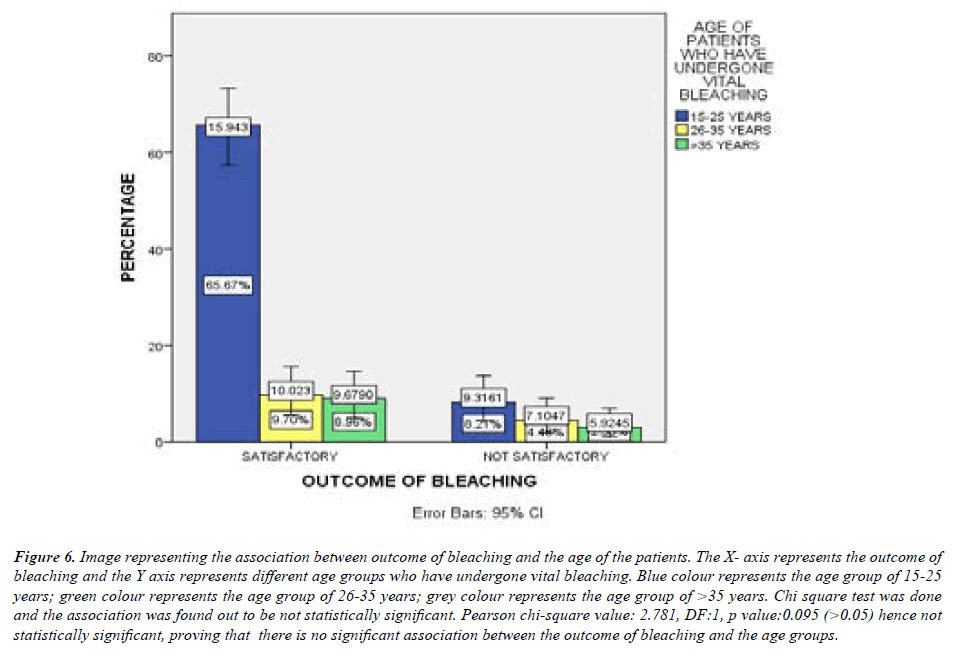Research Article - Journal of Clinical Dentistry and Oral Health (2022) Volume 6, Issue 5
A retrospective esthetic outcome related data analysis in patients undergoing vital bleaching in University setup
Manivannan S and Teja KV*
Department of Conservative Dentistry and Endodontics, Saveetha Dental College and Hospitals, Saveetha University, Chennai, India
- Corresponding Author:
- Teja KV
Department of Conservative Dentistry and Endodontics
Saveetha Dental College and Hospitals
Saveetha University, Chennai, India
E-mail: venkatatejak.sdc@saveetha.com
Received: 01-September-2022, Manuscript No. AACDOH-22-70337; Editor assigned: 05-September-2022, PreQC No. AACDOH-22-70337 (PQ); Reviewed: 19-September-2022, QC No. AACDOH-22-70337; Revised: 23-September-2022, Manuscript No. AACDOH-22-70337 (R); Published: 30-September-2022, DOI:10.35841/aacdoh-6.5.123
Citation: Manivannan S, Teja KV. A retrospective esthetic outcome related data analysis in patients undergoing vital bleaching in University setup. J Clin Dentistry Oral Health. 2022;6(5):123
Abstract
Introduction: Nowadays, cosmetic dentistry has become one of the most important sections of dentistry because patients care about the appearance of their smile with their general health. However there are no previous studies to encounter the clinical outcome after vital bleaching hence, the present study was conducted to find out the aesthetic outcome after vital bleaching. Aim: To find out the aesthetic clinical outcome of vital bleaching in a private dental hospital. Materials and methods: A total of 134 patients who had undergone vital bleaching were included in the study. The collected data was subjected to data analysis. Results and Discussion: Satisfactory outcome was seen in 84.3% of patients who have undergone vital bleaching. 15-25 years is the most common age group who have undergone vital bleaching (73.9%); Male have more commonly undergone vital bleaching (71%) than females ; Sextant 2 is the most common tooth region which has undergone vital bleaching; p-value :0.044 (>0.05) proving that there is no significant association between the outcome of bleaching and the teeth region which has undergone vital bleaching;, p value :0.095 (>0.05) proving that there is no significant association between the outcome of bleaching and the age groups Conclusion: The present study suggests that vital bleaching has proven to produce satisfactory clinical aesthetic outcome. This study will shed light for future studies that study an even larger population prospective RCTs are needed to further support our evidence.
Keywords
Bleaching, Aesthetic, Outcome, Retrospective, Innovation, Dental innovation.
Introduction
Currently, tooth whitening is one of the most popular aesthetic procedures in dentistry [1]. Dental market offers a variety of products, and literature shows different successful techniques for tooth whitening. Clinicians may have the difficulty to decide the most suitable treatment for each case [2]. Vital tooth bleaching refers to the clinical application of a chemical solution to a tooth surface in order to achieve a lightening effect. Despite the large number of techniques described in the literature concerning the external bleaching of vital teeth, all are based on the direct use of hydrogen peroxide (H2O2) or its precursor, carbamide peroxide [3].
The apparent color of a tooth is a combination of its innate color along with the stains present within and on the tooth surface. The Chromogens when deposited on the surface of the tooth or within the pellicle layer discolour the tooth and are termed extrinsic stains [4,5]. Extrinsic stains occur when Chromogens such as tobacco, tea, coffee, red wine, medicines, spices, and plaque attach directly to the tooth. Chromogens such as polyvalent metal salts such as iron supplements and cation antiseptics such as chlorhexidine may combine with tea and attach to the tooth indirectly; creating black or brown characteristic stains [6]. Prophylactic procedures may remove extrinsic stains; however, the more persistent stains respond successfully to bleaching.
Fluorosis may be depicted with varying severities. Discolorations due to simple-to-moderate fluorosis can be treated with bleaching [7]. Hypomineralization when it reaches the dentin enamel junction may result in post eruptive breakdown (PEB), staining the tooth dark brown to black. PEB-stained teeth require a combination of bleaching, micro abrasion, followed by veneers to camouflage the discoloration [8]. Bleaching, though promising may not guarantee success in all cases or may fail to satisfy a patient's high expectations. The indications and contraindications are basically the same for both in-office and home bleaching. Patient's lifestyle, current levels of tooth sensitivity, the type of discoloration, baseline shade of the teeth, and time available for bleaching are important factors to be contemplated while selecting the bleaching technique. Patients with decay, periapical lesion, and sensitivity should seek treatment for the same prior to bleaching. Bleaching is contraindicated in pregnant women as the effects of bleaching materials on the foetus are yet to be investigated [9]. Among various aspects to be considered, the long-term effect of bleaching is an important factor that might be decisive for treatment's choice. There are no previous studies to encounter the clinical outcome after vital bleaching. With this background in mind, the current study fulfils these lacunae and aims to find out aesthetic clinical outcomes among the patients following the treatment of vital bleaching. Our team has extensive knowledge and research experience that has translate into high quality publications [10-29].
Materials and Methods
Study designs and study setting
The present study was conducted in the University setting (Saveetha Dental College and Hospitals, Chennai, India). Thus the data available is of patients from the same geographic location and have similar ethnicity. This retrospective study was carried out with the help of digital case records of patients who reported to the hospital. Ethical clearance to conduct this study was obtained from the scientific review board of the hospital.
Sampling
Data of 134 patients were reviewed and then extracted. All patients who have undergone vital bleaching in the given duration of time period were evaluated. Only relevant data was included to minimize sampling bias. Simple random sampling method was carried out. Cross verification of data for error was done by presence of additional reviewer and by photographic evaluation. Incomplete data collection was excluded from the study.
Data collection
A single calibrated examiner evaluated the digital case records of patients who reported to Saveetha Dental College from June 2019 to March 2021. For the present study, inclusion criteria were data of patients who had undergone vital bleaching treatment and who had reported for follow up. Data obtained were age, gender, teeth region, clinical aesthetic outcome present. All obtained data were tabulated into Microsoft excel documents. Statistical analysis The collected data was tabulated and analysed with Statistical Package for Social Sciences for Windows, version 20.0 (SPSS Inc., Vancouver style) and results were obtained. Categorical variables were expressed in frequency and percentage. Chi square test was used to test association between categorical variables. Chi square tests were carried out using age, gender and as independent variables and dependent variables. The statistical analysis was done by Pearson Chi square test. P value <0.05 was considered statistically significant.
Results and Discussion
In this study we found out that the 15-25 years is the most common age group to undergo the treatment of vital bleaching. Similar findings were seen in the study conducted by Rezende et al. The reason for this finding is the very obvious fact that esthetics plays a very vital role in this age group. People's concerns about their esthetics have increased in recent years due to the media and their advertisements. Next, the simplicity of the procedure and speedy result of tooth bleaching lead to improved patient attitudes and feelings toward esthetic dentistry in this age group [30].
It is commonly thought that women are more interested in their appearance than men [31]. Contradicting this, in our study Male patients was found to be more concerned with their dental appearance than females since they have undergone the treatment for vital bleaching. The reason for this may be males are most commonly exposed to extrinsic stains due to tobacco usage etc. Similar results were seen in the study conducted in Sweden found that men regarded dental appearance as more important than women while other studies found that the differences were not significant [32,33]. Gender associated differences in satisfaction with dental appearance may require further investigations.
The most important finding of this study was that most patients (84.3%) felt a satisfactory outcome after the vital bleaching technique. Only a minimal percentage of patients (15.7%) felt not satisfactory over clinical outcome from vital bleaching. Similar results were seen in the study conducted by Leonard, et al. [34].
To minimize the risks, the involvement of dental professionals, the prevention of using of OTC bleaching products and the reduction of overused of bleaching products are necessary. In addition to that interval of 2 weeks post-bleaching procedure is found to be adequate to avoid adverse effects on the polymerization.
Finally, Clinicians should inform their patients about the possible changes that may occur on their dental restorations during bleaching procedure as well as the possibility of replacement of the bleached restorations at the end of bleaching treatment. It is important that Dentists handle the peroxides with the essential knowledge, because it is demonstrated that satisfactory final results of this technique depend on the correct diagnosis of stains, management of the substrates (enamel and dentin) and as well sensitivity [35].
The strength of this study was that the records of patients seen during the period of study were used; therefore there was no issue regarding declined participation from patients and in addition there was no issue regarding improper patient selection. The weakness of the study being a retrospective study, there was no possibility for direct interaction with the patients and the study relied only on the case sheets, reviews and the sample size was also limited. However this study will shed light for future studies that study an even larger population prospective RCTs are needed to further support our evidence (Figures 1-6).
Figure 1: Image representing the frequency distribution of different age groups of patients who have undergone vital bleaching. X-axis shows the different age groups while Y-axis shows the percentage of patients. This graph shows that Higher number of patients in the age group of 15-25 years have undergone vital bleaching 73.9%(n=99); followed by the age group of 26-35 years 14.2% (n=19); >35 years 11.9% (n=16).
Figure 2: Image representing the frequency distribution of males and females who have undergone vital bleaching. X-axis shows the gender while Y-axis shows the percentage of patients who have undergone vital bleaching. Higher number of male patients 70.1% (n=94) have undergone treatment of vital bleaching than male patients 29.9% (n=40).
Figure 3: Image representing the frequency distribution of different teeth regions which have undergone vital bleaching. X-axis shows the different teeth region while Y-axis shows the percentage of patients with vital bleaching. Higher number of patients had undergone vital bleaching in sextant 2 87.3% (n=117); followed by Sextant 5 12.7% (n=17).
Figure 4:Image representing the frequency distribution clinical outcome of vital bleaching. X-axis shows the clinical outcome while Y-axis shows the percentage. Higher number of patients felt a satisfactory outcome from vital bleaching 84.3% (n=113); 15.7% (n=21) felt not satisfactory over clinical outcome from vital bleaching.
Figure 5:Image representing the association between outcome of bleaching and the teeth region. The X- axis represents the outcome of bleaching and the Y axis represents the number of sextants which have undergone vital bleaching. Blue colour represents sextant 2 and green colour represents sextant 5. Chi square test was done and the association was found out to be statistically significant. Pearson chi-square value: 6.250, DF: 2, p Value: 0.044 (>0.05) hence not statistically significant, proving that there is no significant association between the outcome of bleaching and the teeth region which has undergone vital bleaching.
Figure 6:Image representing the association between outcome of bleaching and the age of the patients. The X- axis represents the outcome of bleaching and the Y axis represents different age groups who have undergone vital bleaching. Blue colour represents the age group of 15-25 years; green colour represents the age group of 26-35 years; grey colour represents the age group of >35 years. Chi square test was done and the association was found out to be not statistically significant. Pearson chi-square value: 2.781, DF:1, p value:0.095 (>0.05) hence not statistically significant, proving that there is no significant association between the outcome of bleaching and the age groups.
Conclusion
The present study suggests that vital bleaching has proven to produce satisfactory clinical aesthetic outcome. This study will shed light for future studies that study an even larger population prospective RCTs are needed to further support our evidence.
Author Contributions
Shruthi M: Literature search, data collection, analysis, manuscript drafting.
Kavalipurapu Venkata Teja: Data verification, manuscript drafting.
Acknowledgement
The authors would thank all the participants for their valuable support and authors thank the dental institution for the support to conduct.
Conflict of Interest
All the authors declare that there was no conflict of interest in present study.
Source of Funding
The present project is supported and funded by
Saveetha institute of Medical and Technical Sciences, Saveetha Dental College and Hospitals, Saveetha University, India
References
- Joiner A. The bleaching of teeth: A review of the literature. J Dent. 2006;34(7):412-419.
- Auschill TM, Hellwig E, Schmidale S, et al. Efficacy, side-effects and patients’ acceptance of different bleaching techniques (OTC, in-office, at-home). Oper Dent. 2005;30(2):156-163.
- Duran DS, Sanchez Duran D, Benavides Reyes C, et al. Bleaching of non-vital teeth to remove intrinsic stains. J Clin Exper Dent. 2017;24.
- Watts AM, Addy M. Tooth discolouration and staining: A review of the literature. Br Dental J. 2001;190(6).
- Joiner A. Tooth colour: A review of the literature. J Dentist. 2004;32:3-12.
- Goldstein RE, Garber DA. Complete dental bleaching. Quint Publish. 1995.
- Croll T. Enamel microabrasion. Quint Publish. 1991.
- Leonard Jr RH, Haywood VB, Caplan DJ, et al. Nightguard vital bleaching of tetracycline?stained teeth: 90 months post treatment. J Esth Restor Dentis. 2003;15(3):142-53.
- Sulieman M. An overview of bleaching techniques: 2. Night Guard Vital Bleaching and non-vital bleaching. Dental Update. 2005;32(1):39-46.
- Muthukrishnan L. Imminent antimicrobial bioink deploying cellulose, alginate, EPS and synthetic polymers for 3D bioprinting of tissue constructs. Carbo Poly. 2021;260:117774.
- PradeepKumar AR, Shemesh H, Nivedhitha MS, et al. Diagnosis of vertical root fractures by cone-beam computed tomography in root-filled teeth with confirmation by direct visualization: A systematic review and meta-analysis. J Endo. 2021;47(8):1198-214.
- Chakraborty T, Jamal RF, Battineni G, et al. A review of prolonged post-COVID-19 symptoms and their implications on dental management. Int J Environ Res Public Health. 2021;18(10):5131.
- Muthukrishnan L. Nanotechnology for cleaner leather production: A review. Environ Chem Lett. 2021;19(3):2527-2549.
- Teja KV, Ramesh S. Is a filled lateral canal–A sign of superiority?. J Dent Sci. 2020;15(4):562.
- Narendran K, MS N, Sarvanan A. Synthesis, characterization, free radical scavenging and cytotoxic activities of phenylvilangin, a substituted dimer of embelin. Ind J Pharmac Sci. 2020;82(5):909-12.
- Reddy P, Krithikadatta J, Srinivasan V, et al. Dental caries profile and associated risk factors among adolescent school children in an urban South-Indian city. Oral Health Prev Dent. 2020;18(1):379-86.
- Sawant K, Pawar AM, Banga KS, et al. Dentinal microcracks after root canal instrumentation using instruments manufactured with different NiTi alloys and the SAF system: A systematic review. App Sci. 2021;11(11):4984.
- Bhavikatti SK, Karobari MI, Zainuddin SL, et al. investigating the antioxidant and cytocompatibility of Mimusops elengi linn extract over human gingival fibroblast cells. Int J Enviro Res Public Hea. 2021;18(13):7162.
- Karobari MI, Basheer SN, Sayed FR, et al. An in vitro stereomicroscopic evaluation of bioactivity between Neo MTA Plus, Pro Root MTA, BIODENTINE and glass ionomer cement using dye penetration method. Mat. 2021;14(12):3159.
- Rohit Singh T, Ezhilarasan D. Ethanolic extract of Lagerstroemia speciosa (L.) Pers., induces apoptosis and cell cycle arrest in HepG2 cells. Nutr Cancer. 2020;72(1):146-56.
- Ezhilarasan D. MicroRNA interplay between hepatic stellate cell quiescence and activation. Euro J Pharmacol. 2020;885:173507.
- Romera A, Peredpaya S, Shparyk Y, et al. Bevacizumab biosimilar BEVZ92 versus reference bevacizumab in combination with FOLFOX or FOLFIRI as first-line treatment for metastatic colorectal cancer: A multicentre, open-label, randomised controlled trial. Lancet Gastroenterol Hepatol. 2018;3(12):845-55.
- Raj R K. β?Sitosterol?assisted silver nanoparticles activates Nrf2 and triggers mitochondrial apoptosis via oxidative stress in human hepatocellular cancer cell line. J Biomed Mat Res Part A. 2020;108(9):1899-908.
- Vijayashree Priyadharsini J. In silico validation of the non?antibiotic drugs acetaminophen and ibuprofen as antibacterial agents against red complex pathogens. J Periodontol. 2019;90(12):1441-8.
- Priyadharsini JV, Girija AS, Paramasivam A. In silico analysis of virulence genes in an emerging dental pathogen A. baumannii and related species. Archiv Oral Biol. 2018;94:93-8.
- Uma Maheswari TN, Nivedhitha MS, Ramani P. Expression profile of salivary micro RNA-21 and 31 in oral potentially malignant disorders. Braz Oral Res. 2020;34.
- Gudipaneni RK, Alam MK, Patil SR, et al. Measurement of the maximum occlusal bite force and its relation to the caries spectrum of first permanent molars in early permanent dentition. J Clini Pediatr Dent. 2020;44(6):423-8.
- Chaturvedula BB, Muthukrishnan A, Bhuvaraghan A, et al. Dens invaginatus: a review and orthodontic implications. Br Dent J. 2021;230(6):345-50.
- Kanniah P, Radhamani J, Chelliah P, et al. Green synthesis of multifaceted silver nanoparticles using the flower extract of Aerva lanata and evaluation of its biological and environmental applications. Chem Select. 2020;5(7):2322-31.
- Rezende M, Loguercio AD, Kossatz S, et al. Predictive factors on the efficacy and risk/intensity of tooth sensitivity of dental bleaching: A multi regression and logistic analysis. J Dent. 2016;45:1–6.
- Vallittu PK, Vallittu ASJ, Lassila VP. Dental aesthetics: A survey of attitudes in different groups of patients. J Dent. 1996;24:335–8.
- Akarslan ZZ, Sadik B, Erten H, et al. Dental esthetic satisfaction, received and desired dental treatments for improvement of esthetics. In J Dental Res. 2009;20(2):195.
- Xiao J, Zhou XD, Zhu WC, et al. The prevalence of tooth discolouration and the self?satisfaction with tooth colour in a Chinese urban population. J Oral Rehab. 2007;34(5):351-60.
- Leonard Jr RH, Bentley C, Eagle JC, et al. Nightguard vital bleaching: a long-term study on efficacy, shade retention, side effects, and patients' perceptions. J Esthe Rest Dent. 2001;13(6):357.
- Dudek M, Roubickova A, Comba L, et al. Effect of postoperative peroxide bleaching on the stability of composite to enamel and dentin bonds. Operat Dent. 2013;38(4):394-407.
Indexed at, Google Scholar, Cross Ref
Indexed at, Google Scholar, Cross Ref
Indexed at, Google Scholar, Cross Ref
Indexed at, Google Scholar, Cross Ref
Indexed at, Google Scholar, Cross Ref
Indexed at, Google Scholar, Cross Ref
Indexed at, Google Scholar, Cross Ref
Indexed at, Google Scholar, Cross Ref
Indexed at, Google Scholar, Cross Ref
Indexed at, Google Scholar, Cross Ref
Indexed at, Google Scholar, Cross Ref
Indexed at, Google Scholar, Cross Ref
Indexed at, Google Scholar, Cross Ref
Indexed at, Google Scholar, Cross Ref
Indexed at, Google Scholar, Cross Ref
Indexed at, Google Scholar, Cross Ref
Indexed at, Google Scholar, Cross Ref
Indexed at, Google Scholar, Cross Ref
Indexed at, Google Scholar, Cross Ref
Indexed at, Google Scholar, Cross Ref
Indexed at, Google Scholar, Cross Ref
Indexed at, Google Scholar, Cross Ref
Indexed at, Google Scholar, Cross Ref
Indexed at, Google Scholar, Cross Ref
